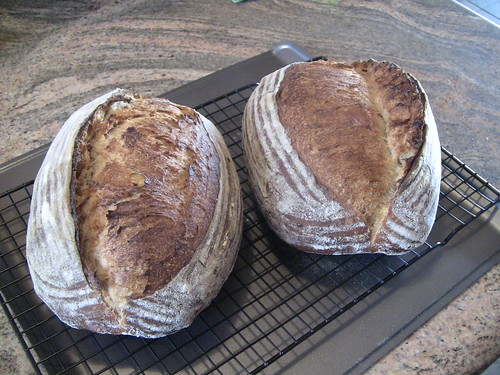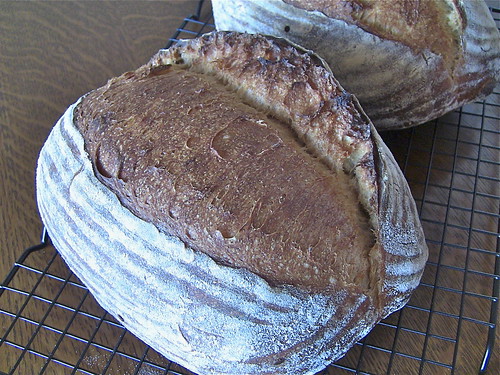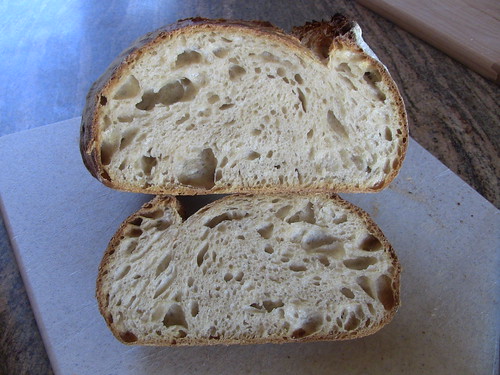
They say everything happens for a reason, and I believe them. But I can’t always identify the reasons some things happen. Why was this bake of the San Francisco Country Sourdough (my version of pain de campagne) the best ever? This was probably the 7th or 8th time I’ve baked it, but this one had that je-ne-sais-what like my best bakes of Tartine BCB and last week’s bake of Hamelman’s pain au levain. Beautifully caramelized, golden brown, crispy crust; moist, airy-but-substantial crumb, with nicely gelatinized membranes; complex wheaty flavor with a hint of rye.
I guess I should compare this to other bakes of the same formula.
Here’s what was the same:
- The ingredients and the basic technique (described below).
Here’s what might have been different:
- My starter was very active (after last week’s near-death experience).
- Both the primary ferment (3 ¼ hours) and the proof (2 ¼ hours) were on the long side.
- My handling/shaping skills are improving, and I got a nice taut sheath.
- I made a recipe-and-a-half so I could cold retard one loaf’s worth to bake tomorrow for some friends.
Whatever factor(s) made the difference, I hope I can do it again.



And excellent with some early Autumn barbecue.

San Francisco Country Sourdough (Sourdough Pain de Campagne) version 10-8-11
Yield: Two 750g Loaves; or Three Mini-Baguettes (235g each) and one 800g Loaf; or One 1000g loaf and two 250g baguettes; 0r Three 500 gram loaves; or…
Ingredients
LIQUID-LEVAIN BUILD
100 grams AP flour
24 grams Whole Wheat flour
12 grams Whole rye flour
170 grams Water, cool (60 F or so)
28 Mature culture (75% hydration)
FINAL DOUGH (67% hydration, including levain)
640 grams All-Purpose flour (83%)*
85 grams Whole wheat flour (11%)**
45 grams Whole rye flour (6%)
435 grams Warm water (80 F or so) (56%)
17 grams Salt (2%)
306 Liquid levain (48%)
* used CM Artisan Baker’s Craft (malted)
** used CM Organic Hi-protein fine whole wheat
Directions
1. LIQUID LEVAIN: Make the final build 12 to 15 hours before the final mix, and let stand in a covered container at about 70°F
2. MIXING: Add all the ingredients to the mixing bowl, including the levain, but not the salt. Mix just until the ingredients are incorporated into a shaggy mass. Correct the hydration as necessary. Cover the bowl and let stand for an autolyse phase of 30 to 60 minutes. At the end of the autolyse, sprinkle the salt over the surface of the dough, and finish mixing 5 minutes. The dough should have a medium consistency.
3. BULK FERMENTATION WITH S&F: 3 hours. Stretch and fold the dough in the bowl twice 20-strokes at 45-minute intervals. Place dough ball in lightly oiled bowl, and stretch and fold on lightly floured board at 45 minutes. If the dough has not increased in size by 75% or so, let it go a bit longer.
4. RETARDED BULK FERMENTATION (optional): After second S&F on board, form dough into ball and then place again in lightly oiled bowl. Refrigerate 8-20 hours, depending on sourness desired and scheduling convenience.
5. DIVIDING AND SHAPING: [Note: if bulk retarded, let dough come to room temperature for 30-90 minutes before pre-shaping.] Divide the dough into pieces and pre-shape. Let sit on board for 30-45 minutes, and then shape into boules or batards or baguettes.
6. PROOFING: Approximately 1.5 to 2.5 hours at 72° F. Ready when poke test dictates. Pre-heat oven to 500 with steam apparatus in place.
7. BAKING: Slash loaves. Bake with steam, on stone. Turn oven to 450 °F after it hits 500F after loading loaves. Remove steaming apparatus after 12 minutes (10 for baguettes). Bake for 35 to 40 minutes total (for 750g loaves; less for smaller loaves). Rotate loaves for evenness as necessary. When done (205 F internal temp), leave loaves on stone with oven door ajar 10 minutes.
Happy baking!
Glenn
Submitted to http://www.wildyeastblog.com/category/yeastspotting/